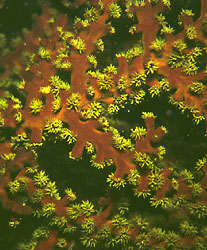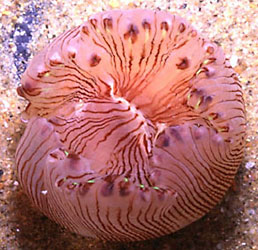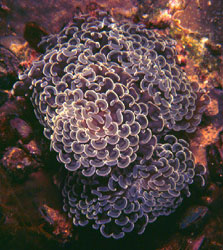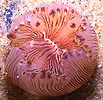Scleractinia
Stony star corals
Sandra L. Romano and Stephen D. Cairns- Stylophylliina

- Pachythecalina

- Archaeocoeniina
- Archaeofungiina

- Stylina

- Fungiina
- Astraeoina
- Faviina
- Caryophylliina
- Distichophylliina

- Meandriina
- Poritiina
- Dendrophylliina
Introduction
The Scleractinia (scler = hard, actinia = ray), or stony star corals, are polyp animals that are found exclusively in marine habitats. They are very similar to sea anemones but they secrete a hard skeleton. Stony star corals are divided ecologically into two groups. One group, the reef-builders, are the best known scleractinian corals. They are found mostly in the clear, shallow waters of the tropics. The second group does not build reefs and is found in all regions of the oceans, including temperate and polar regions from relatively shallow waters down to 6000 m. An example of a non-reef-building-coral is Tubastraea coccinea.The most recent taxonomic revision of the Scleractinia (Veron, 1995, 2000) divides the order into 13 suborders of which 7 have living representatives. Nine of these suborders were present in the Mid-Triassic (240 million years ago) when the Scleractinia first appear in the fossil record. Three more suborders originated in the Jurassic (200 million years ago) and one suborder originated in the Mid-Cretaceous (100 million years ago). These suborders are differentiated from one another primarily by characteristics of the septa -- the radial partitions of the skeleton that serve to separate and support the mesenteries of the polyp.
This page is currently under construction and will be greatly amplified in the near future.
References
Veron, J. E. N. 1995. Corals in Space and Time: The Biogeography and Evolution of the Scleractinia. University of New South Wales Press, Sydney, 321 pp.
Veron, J. E. N. 2000. Corals of the World. Australian Institute of Marine Science, Townsville. 3 vol.
Williams, G. C. 1986. What are Corals? Sagittarius, 1(2): 11-15.
Title Illustrations

| Scientific Name | Tubastraea micrantha |
|---|---|
| Location | collected from shallow water off Pelau |
| Comments | A living colony having branches about 2 cm in diameter. Although azooxanthellate, this species often attains a colony size of up to a meter and thus contributes to reef structure. |
| Copyright | © D. Faulkner |
About This Page
Creation of this page was supported by US National Science Foundation grants DEB95-21819 and DEB 99-78106 (in the program PEET - Partnerships to Enhance Expertise in Taxonomy) to Daphne G. Fautin, grant DEB99-78086 (in the program PEET) to Stephen D. Cairns, and grant OCE 00-03970 (in NOPP, the National Oceanographic Partnership Program) to D.G.F. and Robert W. Buddemeier.Technical assistance was rendered by Adorian Ardelean.
Sandra L. Romano

University of the Virgin Islands, St. Thomas, USVI

Smithsonian Institution, Washington, D. C., USA
Correspondence regarding this page should be directed to Sandra L. Romano at
Page copyright © 2002 and
All Rights Reserved.
- First online 28 October 2002
Citing this page:
Romano, Sandra L. and Stephen D. Cairns. 2002. Scleractinia. Stony star corals. Version 28 October 2002 (under construction). http://tolweb.org/Scleractinia/17653/2002.10.28 in The Tree of Life Web Project, http://tolweb.org/












 Go to quick links
Go to quick search
Go to navigation for this section of the ToL site
Go to detailed links for the ToL site
Go to quick links
Go to quick search
Go to navigation for this section of the ToL site
Go to detailed links for the ToL site